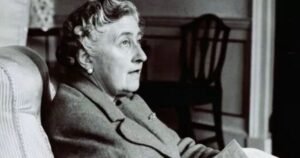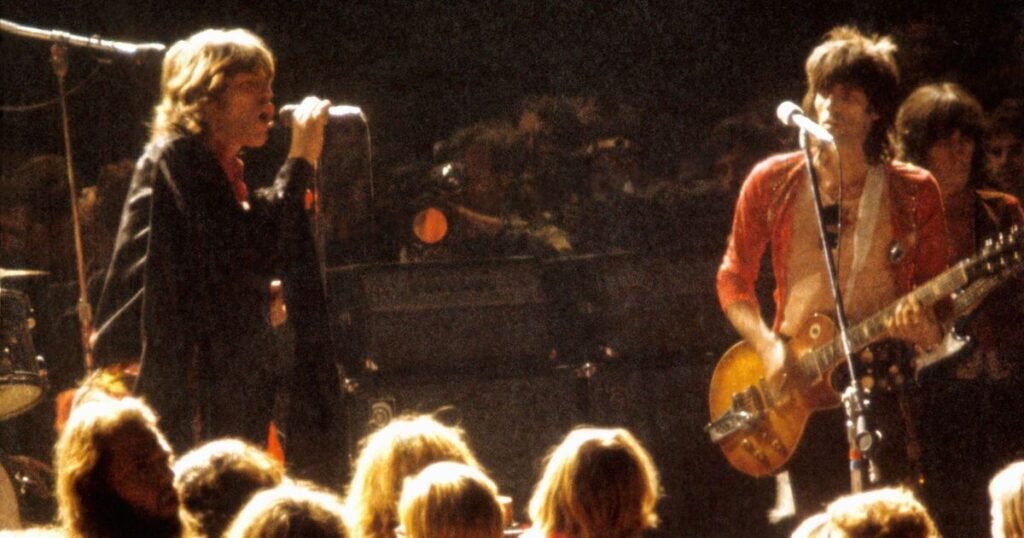The REAL story behind the Rolling Stones’ notorious Altamont concert | UK | News

Mick Jagger and Keith Richards on stage at the now notorious Altamont festival (Image: Getty)
The Rolling Stones had just begun Under My Thumb and Mick Jagger was only a line or so into the song when music writer Stanley Booth, standing beside guitarist Keith Richards’ amplifier, spotted movement in front of the stage.
His eye was drawn to a young man in a lime-green suit, black hat and shirt, carrying a nickel-plated revolver.
It was December 6, 1969. Some 300,000 revellers were at the ill-fated Altamont Free Concert on a raceway outside San Francisco. It was only four months after the “peace and love” of the legendary Woodstock festival in upstate New York, but both were in short supply as the likes of Jefferson Airplane and Crosby, Stills, Nash & Young performed.
Today the event is recalled largely for the notorious decision to employ members of the violent Hells Angels motorbike gang as security – “Any one of them would just as soon kill you as look at you” – and the tragedy that occurred seconds later under the watchful eye of Stones chronicler Booth.
“The gun waved in the lights for a second, two, then he was hit, so hard, by so many Angels, that I didn’t see the first one – short, Mexican-looking, the one who led me onstage? – as he jumped,” he recalled.
“I saw him as he came down, burying a long knife in the black man’s back. Angels covered the black man like flies on a stinking carcass. They carried the victim behind the stack of speakers and I never saw him again.”
Meredith Hunter, 18, who had attended the concert with his girlfriend Patty Bredehoft, was stabbed and kicked to death.
Hells Angel Alan Passaro, who stabbed Hunter four or five times, was eventually acquitted of murder on the grounds of self-defence after the jury saw footage of the teenager pointing his revolver in the direction of the stage.

Hells Angels patrol the arena before the Rolling Stones appeared at the Altamont Speedway for the free concert they (Image: Hulton Archive)
Doctor Robert Hiatt, who gave Hunter first aid, recalled: “He was limp in my hands and unconscious. He was still breathing then, though quite shallowly, and he had a very weak pulse. It was obvious he wasn’t going to make it, but if anything could be done, he would have to get to a hospital quickly. He had very serious wounds.”
As the Stones, who had stopped playing in the mayhem, struck up Under My Thumb again (later, it would pass into legend they had been playing Sympathy For The Devil when the killing occurred, but this wasn’t true), Booth recalled: “The band sounded amazingly sharp. The crowd was more still.
“Without knowing exactly what, we all felt that something bad had happened. I assumed, and I was not given to flights of horrible imaginings, that the Angels had killed several people.”
The horrifying details emerged as the clock ran out on the decade, and the incident, for many, marked the metaphorical as well as the literal end of the Sixties’ era of optimism and idealism. The Altamont tragedy would provide the climax to Booth’s unparalleled insider account of the Stones’ North American tour in the autumn of 1969 and the release of their eighth studio album, Let It Bleed, both of which heralded their arrival as a force to be reckoned with – the self-proclaimed “greatest rock ‘n’ roll band in the world”.
The Georgia-born music journalist had met the band when he travelled to London in 1968 to cover the trial of founder member Brian Jones who, amid increasing problems with addiction, had been charged with possession of cannabis.
There, Booth became friends with Keith Richards and was soon drawn into the group’s inner circle, sharing their confidences and their drugs – including taking heroin with Richards.
The British band embraced the American, who had been brought up in Memphis, Tennessee, due to his authentic knowledge of the music they admired as well as his journalistic connections to many of the original US bluesmen.
“I wrote a story but I had only glimpsed – in Brian’s eyes as he glanced up from the dock – the mystery of the Rolling Stones,” Booth would recall.
“In the spring, after the story was published, I asked the Stones for their cooperation in writing a book about them. It was June, and I was still waiting for an answer, when Brian, who had started the band, left it because, he said, of ‘musical differences’ with the other Stones.”
Less than a month later, in July 1969, Jones – “a very, very good guitar player, and he was very mercenary too, very keen on money” – drowned in the swimming pool of his East Sussex home aged just 27.

Altamont victim Meredith Hunter was beaten and stabbed to death after brandishing a revolver (Image: Public domain)
Shirley Arnold, a fan who became manager of the Stones’ fanclub, recalled his funeral: “We all stood over the side to watch, you’re supposed to watch the coffin go down. It was hot, cameras were clickin’, it was so sick, takin’ photographs.
“I remember seeing the coffin going down and it was going such a long way. I thought I was going down the hole…’”
As they regrouped following the shock, Booth persuaded the band to allow him to accompany their next tour as a sort of embedded correspondent.
They offered him a deal, but he refused, stating that “you can’t do good work that way – you have to write the best you can and share control of nothing, neither the manuscript nor the money”. Booth got them to sign a letter giving him permission to write what he wanted, and the access he gained as a friend and confidant would leave today’s music writers speechless. He trailed them through stadiums, hotels and airports, on buses, limousines and planes, rubbing along with groupies, bodyguards and roadies, a life “composed of distant beaches, soft female skin, plane rides, cold concrete arenas, cops, fatigue, cocaine, heroin, morphine, marijuana, busted amplifiers, riots”.
Booth’s account, the True Adventures of the Rolling Stones, first published in 1984 and now republished in a new edition, remains one of the most vivid and brilliant books ever about rock ‘n’ roll and the late-1960s-early-1970s counterculture.
It isn’t always an easy read, and it certainly wasn’t an easy book to write.
“I would be assaulted by Confederate soldiers and Hells Angels, would go to jail, be run over by a lumber truck on the Memphis-Arkansas bridge, fall off a Georgia waterfall and break my back, have epileptic seizures while withdrawing from drugs,” Booth admitted.
The book doesn’t always reflect well on the band. Booth would reveal, for instance, that when Brian Jones broke his hand in 1966, it was not from falling down a hillside as he had claimed, but in a domestic dispute with his girlfriend, actress Antia Pallenberg.
“Years later Anita told me Brian had broken his hand on her face, during a fight. ‘He always hurt himself,’ she said. ‘He was very fragile, and if he ever tried to hurt me he always wound up hurting himself.’”

Mick Jagger on stage with the Stones at Madison Square Gardens in November 1969 (Image: Getty)
While on their way backstage before the Altamont show, he revealed: “People were tossing us joints and things. Looking at a yellow-green LSD tab, Charlie asked, ‘D’you want it?’ I said: ‘I ain’t too sure about this street acid. Maybe Keith will want it.’”
Another time, in a hotel, he writes: “‘Isn’t there any grass in this town?’ Keith asked. One of the boys left, coming back a few minutes later with a plastic sandwich bag of marijuana. We smoked it, rolled into great cigars, listening to Elmore James.”
The author, who married three times, died aged 82 shortly before Christmas, but his book remains an example of the best writing about popular music ever put down on paper.
Booth was born in Waycross, Georgia, the son of an insurance company vice-president and a schoolteacher. He studied English at Memphis State University then postgraduate studies at Tulane University in New Orleans, before leaving his course to return to Memphis in 1964 where he began his career as a journalist, writing features for the likes of Playboy, Esquire and Vanity Fair.
“A teenager in the 1950s – I was 12 years old in 1954, the year Elvis Presley made his first recording – I had been given a new sense of life by rock and roll, a sense that diminished as the quality of the music diminished. Now musicians my own age, like the Stones, again were taking up the music,” he wrote.
If Booth’s book chronicled the beginning of the Stones’ transformation into rock behemoth, it’s evident he didn’t entirely agree with their ultimate direction.
“Following the tour that ended with Altamont, I went to live in England and stayed until, after a certain weekend at [Richards’ Sussex home] Redlands, I decided that if Keith and I kept dipping into the same bag, there would be no book and we would both be dead,” he wrote.
“I spent time with the Stones on later tours, and they were always good, but there never seemed to be so much at stake. There was, though, just as much at stake, but it was harder to see…
“At later Stones concerts I gave my seats to people like Sir John Gielgud, and once to a candidate for vice president of the United States.
“Guitar players, producers and women – except for Shirley Watts – came and went, terrible and wonderful things happened, in concert halls, outdoor arenas, nightclubs, jailhouses, courtrooms, bedrooms, as we persisted in our folly.”
He returned to the States and a cabin in the Ozark Mountains where he struggled with drug abuse and depression while trying to write. It took him 15 years – “even longer to write than the Bible”, as Richards memorably remarked.

Veteran music writer Stanley Booth befriended the Stones and nearly lost himself to drugs as a result (Image: Bob Drury)
Booth’s book first appeared in 1984, titled Dance with the Devil: The Rolling Stones and Their Times. “I was trying to write the best book I could write,” Booth explained. “That’s one reason it took so freaking long to write. I literally had to become a different person from the man who lived the story.”
The last time he saw the Stones live, Booth did so as a fan. “I went in like a civilian, with a ticket. Inside the entrance just past the ticket-taker, a girl was passing out applications for Rolling Stones Visa and MasterCards with the tongue logo,” he wrote later.
“I had a vision of Nato leasing the tongue to put on helicopters, tanks, bombs. In the Sixties, we believed in a myth – that music had the power to change people’s lives.
“Today people believe in a myth – that music is just entertainment. The Sixties myth was, need I say, much more interesting – but not so effective as a merchandising tool.”
- The True Adventures of the Rolling Stones by Stanley Booth (Canongate, £14.99) is out now

Stanley Booth’s rip-roaring True Adventures of the Rolling Stones (Image: Canongate)
You may be interested

2 Virginia Beach police officers shot and killed during traffic stop
new admin - Feb 22, 2025Two police officers in Virginia were shot and killed during a traffic stop late Friday night, authorities said.The Virginia Beach…

Lost Records: Bloom & Rage review
new admin - Feb 22, 2025The fuzz of the cathode-ray tube (CRT) monitor, alongside static grains and flickering scanlines, is a touchstone for ’90s-era nostalgia.…

Michigan State takes control of Big Ten with 75-62 win over Michigan
new admin - Feb 22, 2025[ad_1] Jase Richardson scored 21 points and Tre Holloman had 18, leading No. 14 Michigan State to a 75-62 win…





































